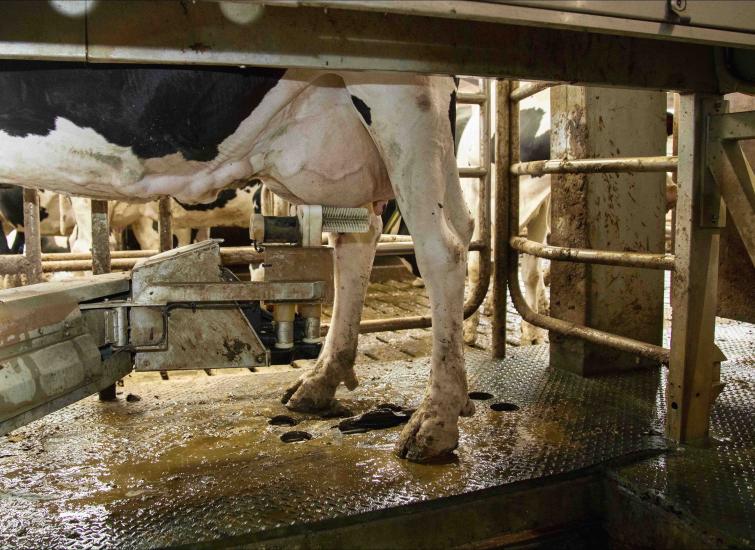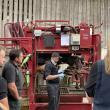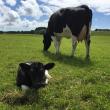We feel that by working with Advanced Nutrition, they are always looking at the bigger picture. They help us to plan ahead as well as keeping the Jersey herd running day-to-day. New ideas on management of the herd are always coming from Advanced Nutrition.
Key considerations when switching to milking robots
The interest in robotic milking continues to increase as producers recognise the benefits of the system. Mike Green at British Dairying spoke to Eoghan Mullery about some of the most important issues to consider when considering robots and the main factors involved in managing the system profitably.

Before investing in milking robots dairy producers must assess carefully if they are committed to the system and have the stockmanship skills to improve herd performance to make a return on their investment. And this will have to be achieved with an acceptable work-life balance.
Robotic systems will not give producers more free time but will allow more flexibility on how they spend their time on the farm, says Eoghan Mullery, Technical Director at Advanced Nutrition. "It gives them more time and information to manage their cows better – and exploit their production potential."
“The most important consideration is how cow performance will improve to provide sufficient extra income to give a return on investment. Robotic milking systems are not for everyone,' he stresses.
Not a panacea
"For example, it is not the answer for farmers struggling to make money on conventional milking systems. Some have unrealistic expectations that low yields and poor cow health will go way if they put in robots. And it won’t allow producers to take more and longer holidays."
Advanced Nutrition's robotic milking division - Advanced Robot - provides advice to farmers thinking of going into robotic systems and can provide an independent view on the key factors to consider.
“Farmer understanding of robotics has increased, which has been helped by increased competition between manufactures,” suggests Eoghan. “We don’t recommend what brand of robot to buy – this is up to the farmer. Manufacturers have sorted out the mechanical problems associated with robotic milking and all brands can milk cows efficiently."
Consider the software
“Now the software provided with the robots is an important factor – is it user friendly, what data is recorded and analysed, what information is available for day-to-day management and does it highlight key performance indicators (KPIs)? Flexibility is also important so the software can help the farmer achieve what they need.”
When considering whether robots are a suitable option for a dairy unit the first factor to look at is the people that will run the system, then the cows and finally the farm facilities.
“The first question we ask is why farmers want to install robots and assess what they want out of it and their objectives. We can tell quickly from this if robots are the right option for them. And at this stage we can dispel myths about going on holiday all the time or turning round a struggling business,” explains Eoghan.
“You may still have to work 12 hours a day but you can be more flexible and choose when you do it. This is a huge consideration for younger farmers who want the freedom to plan social events and family time outside working hours.
Eoghan encourages all farmers to visit and talk to existing robotic producers. "You need to look beyond the robots and smart facilities and find out what the farmer is like. Find out what you have in common with them and if the people working on the unit are happy."
Once it is established that robots may be a positive option for the business, he says there are four main considerations that producers need to concentrate on and get right for the system to be successful and profitable. All require high levels of stockmanship and attention to detail.
- Transition management
- Cow mobility and body condition
- Robot visit behaviour
- Lactation persistency
“Every robotic herd, every year, will go through different challenges and things will need to be monitored and adjusted. But getting these four things right will go a long way to minimising problems."
“Cows milked in parlours typically see peak milk production at 60 to 80 days but on robotic systems it is earlier at 35 to 40 days."
Transition management
"Management in the three week period after calving can make the difference between success and failure. Forty days is not long to get to peak production and so the cows must come into the herd in the right condition. Robots will expose and penalise poor transition management.”
The second aspect is to keep on top of lameness. “You can’t afford to be held back by poor mobility. If mobility, transition management and herd nutrition are right then there will be consistent cow behaviour and visits to the robot throughout the lactation. The more visits to the robot, the better milking frequency which leads to higher production," says Eoghan.
“Producers often overlook the importance of lactation persistency. It is important to keep milking frequency up from mid to late lactation to keep the lactation curve flatter which will give more production over the whole lactation.
“Body condition control can also be neglected in the mid- to late-lactation period. Good transition, mobility and early lactation production are all down to body condition control. Cows are working harder and producers need to ensure even body condition across the herd."
New nutrion approach
Feeding management is a key factor in this and nutrition in robotic systems needs a different approach to conventional milking herds.
“All cows in the UK are fed in the robots. Therefore, producers must balance this purchased feed with forage-based diets outside. We see lots of decent nutrition in robots but find some that are not balanced and not achieving the performance they should be. These can be linked to mobility problems and visit behaviour," he advises.
“If feeding is not right it will lead to having to fetch cows and bring them to the robot for milking. On a parlour system these cows would be hidden but the robotic system will identify them and you cannot afford to carry any passengers."
Feasibility studies can help give producers an independent viewpoint when thinking of investing in robotic milking.
Return on investment
“We look at the costs of production now and the projected COP on the robotic system. From this we can calculate what cow performance needs to be achieved to make a return on investment.For many the yield target will be between 35 and 40 litres per cow per day. This takes a lot of work. For some over 40 litres per cow will have to be achieved and this will take a lot of time, skill and dedication."
Performance targets
“It is vital to set and meet performance targets to ensure that the system gives a return on investment. This includes targets for production and for forage intake to keep the cows healthy. Costs of production will be higher with robotic milking but margin over purchased feeds will be better because cows are producing more milk. So to be successful management needs to be tip top.”
〈 BACK




